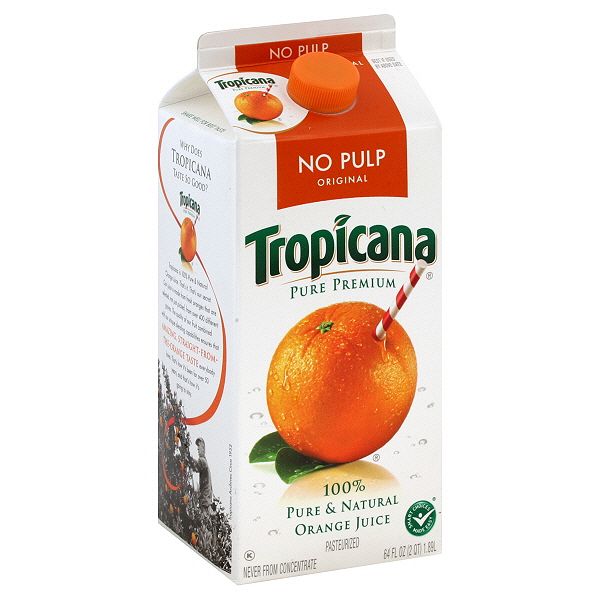Juiced

Tropicana Pure Premium Orange Juice has one ingredient listed on its label: “100% Pure Natural Oranges.” While that’s accurate, it may also be misleading. Why? Because while the ingredients imply that oranges are cut, put into a juicer, and the resulting juice is then packaged, that’s not quite right. The process is much more complicated — and, seemingly, much less pure.
According to a 2003 report from the United States Department of Agriculture (pdf here), orange juice was the most popular juice in the United States, and easily so — it was 2.5 times more popular than the number two on the list, apple juice. Per that report, in order to provide the demanded orange juice to American consumers, one would need about 70 pounds of oranges, per American, year year. And in order to provide that huge amount of orange juice to consumers, companies such as Tropicana go through a long process, one much more involved than simply squeezing a dozen or so oranges and sealing the juice into a box.
In 1963, the U.S. government added an optional but, from a brand quality perspective, hardly avoidable step — pasteurization, which in part involves heating the juice to temperatures higher than one would typically want their juice served at. That year, the Food and Drug Administration (FDA) began to require that unpasteurized juice be labeled as such, replete with a warning that it may contain some pathogens which would have otherwise been removed in the heating process. So most of the orange juice made for sale in the U.S. has, in fact, been pasteurized, as the warnings would scare off most consumers otherwise.
But the pasteurization process removes more than just pathogens. It also reduces the flavor and aroma from the juice. This problem is exacerbated by how commercial juice companies store the juice — something called aseptic processing (described here), which removes the oxygen from the product in order to keep it sterile for a long period of time. After the OJ has undergone all this, it does not taste or smell like the product you are used to drinking at breakfast.
To fix this, large orange juice manufacturers use something called “flavor packs” — additives which are derived from oranges, and specifically from the orange oil excreted from inside the rind. These flavor packs are added to the juice toward the end of the process, and can even be customized to some degree in order to provide consistency between cartons (and perhaps some sort of taste- or smell-driven brand recognition). Food policy scholar Alissa Hamilton, who authored a book about the orange juice production process, told ABC News about these flavor packs, that, while made from oranges (and only oranges), the companies “break [the oranges] down into individual chemicals.” She further told the New Yorker that the companies “then reassemble the individual chemicals in configurations that resemble nothing found in nature.”
The FDA states that flavor packs are regarded as safe, and when ABC News asked Hamilton if she believed the flavor packs were dangerous, she replied with “I don’t know.” (That said, Hamilton does not drink pre-packaged orange juice any more.) But that was not enough for some. Earlier this year, a California consumer by the name of Angelena Lewis (no relation) sued Tropicana (news report here, legal filing here), arguing that the undisclosed use of flavor packs ran afoul of California’s false advertising laws.
Bonus fact: Brush your teeth and then go drink some OJ, and you’re in for a rude surprise — the juice tastes downright awful. What causes that? Most toothpastes contain a compound called sodium laureth sulfate, which causes the foaming action when you brush. But it also blocks your tongue from being able to detect sweetness. So when you drink the juice, you’re unable to taste the sweet aspects; instead, you only sense the bitter/sour parts.
From the Archives: Miracle Berries: A neat little berry which changes the way you taste things.
Related: “Squeezed: What You Don’t Know About Orange Juice” by the aforementioned Alissa Hamilton. 3.3 stars on three reviews. Available on Kindle.

Leave a comment